The Epiphany in Stained Glass

By Glen McCullough
While Mary and Joseph were still in Bethlehem, the three men variously described as ‘wise,’ ‘kings’ or ‘the Magi’ found their way following a star to the stable and knelt before the baby Jesus, worshipped him and declared that Jesus was the Saviour to all. They brought gifts of gold, frankincense and myrrh. The whole event is described in Matthew’s Gospel.The Church commemorates the event on 6 January as the Epiphany, a word the dictionary defines as the manifestation of Christ to the Gentiles as represented by the Magi, or a moment of sudden and great revelation or realisation. I have no doubt it was a moment of sudden and great revelation to Mary and Joseph.
What do we know for sure about the three kings, the three wise men, the Magi? Very little. Matthew is the only one who tells of them. Perhaps Luke thought they were irrelevant in the infancy narrative.
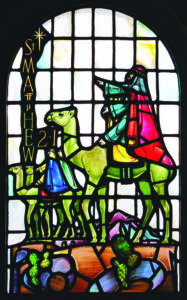
1
Matthew said that wise men came out of the east following a star. The window to the left [1], in First Presbyterian Church, Invercargill, shows them following the star.
They met with King Herod and knelt before Jesus and gave him gifts, shown in these two panels in St Andrew’s Cathedral, Sydney [2]. They went home by another way to avoid Herod. That’s all the Gospel tells us. The rest, I think, is conjecture or tradition.
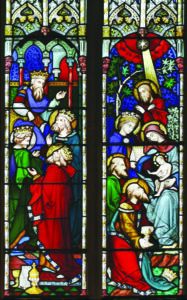
2
They were probably astronomers, because that is what “Magi” implies. They are thought to be kings because the Old Testament refers to kings paying homage (Psalm 72:11, Isaiah 60:3), and they bore very expensive gifts. There is no certainty about numbers – western tradition has three, the number of gifts, but eastern tradition has nine. There is no certainty where they came from, other than ‘the east.’ Early tradition, dating from c.565, had them coming from Persia, but by the 14th century they had names and origins – Caspar from Tarsus (modern day Turkey), Melchior from Arabia and Balthazar from Saba (modern South Yemen), although Balthazar is also attributed to India and is usually depicted with a dark face as shown
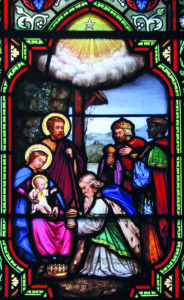
3
in this window from Our Lady of the Sacred Heart, Randwick, Sydney [3]. Apart from being traditional and very colourful, it struck me because Mary is shown as a rather plump matronly figure, and the wise men are shown as kings. One of them has taken his crown off before kneeling at baby Jesus’ feet.
Their gifts had spiritual meaning, apart from their common use - Gold as a symbol of kingship, frankincense (an incense) as a symbol of deity and myrrh (an embalming oil) as a symbol of death. The latter might have foreshadowed Jesus’ sacrifice and it has been said that the gift may have been used to prepare Jesus’ body for burial. The gold was probably used to fund the journey to Egypt and back. This window in St Benedict’s, Auckland [4], shows the gifts very clearly.
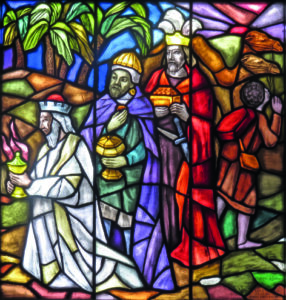
4
The timing of the visit is uncertain. It must have been within two years of Jesus’ birth and before the flight to Egypt, and was possibly after the Presentation in the Temple.
I have seen many representations of the scene. Probably the most orthodox was the one in St Andrew’s Church, Vancouver, Canada [5]. The star is there, an angel hovers, the visitors hold their gifts, and one of them is darker, following the tradition of the Church.
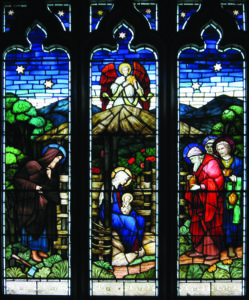
5
Unusually, the baby Jesus looks small enough to be newly born, even though he would have been older than newborn by then. Mary is in her traditional blue. The only break with tradition is the haloes the men have been given - usually they are depicted either without them or wearing crowns.
Completely non-traditional are the next two windows. No. [6] is in the chapel of the Franciscan Friary in Killarney, Ireland. Although rather dark, it shows Mary as a doll-like figure with Joseph’s hand on her shoulder, and Jesus as a beautifully dressed blonde child.
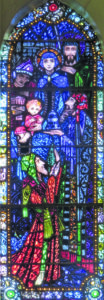
6
No. [7] is in the Chiesa di San Francesco di Rivotorto at the foot of the hill in Assisi, Italy, built as a memorial at the place where St Francis went on retreat. The window is distinctly modern and shows a mature Mary with Jesus as an older child. The three men are depicted as wise men, not kings.
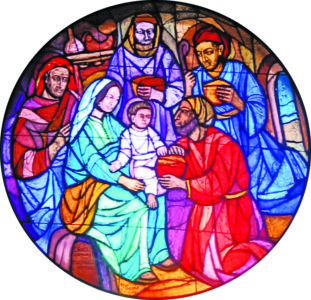
7
Another colourful window (not shown) in St Paul’s, Burwood, Sydney, has the words of Isaiah 60:3 ‘And the Gentiles shall come to thy light, and kings to the brightness of thy rising’ underneath. That prophecy may have led to the belief that the men to whom Matthew referred could have been kings.
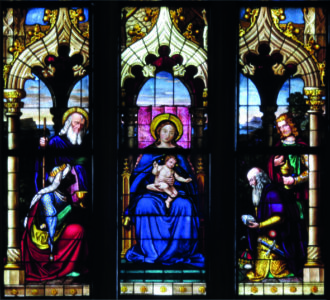
8
The last window [8] is in St Peter’s Cathedral, Regensburg, Germany.
It is located at the rear of the church, above one of the side aisles. My eyes were drawn to it like a magnet as I left the church, simply because of the brilliance of the blue dress Mary is wearing. Preparing the photo for printing has dulled the blue somewhat, but I hope you can get some idea of its beauty.
Hail, Mary!
 Entries(RSS)
Entries(RSS)